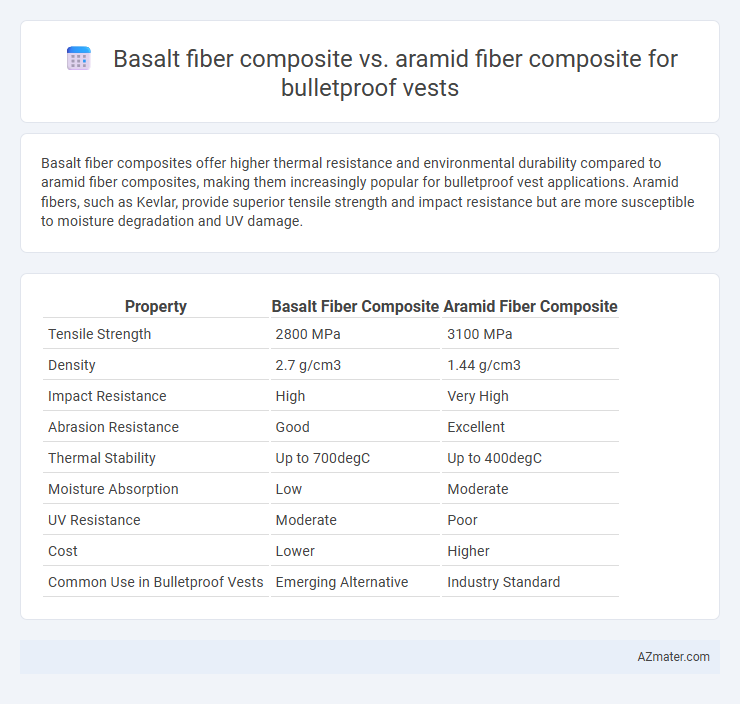Basalt fiber composites offer higher thermal resistance and environmental durability compared to aramid fiber composites, making them increasingly popular for bulletproof vest applications. Aramid fibers, such as Kevlar, provide superior tensile strength and impact resistance but are more susceptible to moisture degradation and UV damage.
Table of Comparison
| Property | Basalt Fiber Composite | Aramid Fiber Composite |
|---|---|---|
| Tensile Strength | 2800 MPa | 3100 MPa |
| Density | 2.7 g/cm3 | 1.44 g/cm3 |
| Impact Resistance | High | Very High |
| Abrasion Resistance | Good | Excellent |
| Thermal Stability | Up to 700degC | Up to 400degC |
| Moisture Absorption | Low | Moderate |
| UV Resistance | Moderate | Poor |
| Cost | Lower | Higher |
| Common Use in Bulletproof Vests | Emerging Alternative | Industry Standard |
Introduction to Bulletproof Vests
Bulletproof vests rely on advanced composite materials to provide ballistic protection, with basalt fiber and aramid fiber composites as prominent options. Basalt fiber composites offer enhanced thermal stability and environmental resistance, while aramid fiber composites, such as Kevlar, are widely recognized for their exceptional tensile strength and energy absorption capabilities. Selecting the optimal fiber composite impacts the vest's weight, flexibility, and overall protective performance against high-velocity projectiles.
Overview of Basalt Fiber Composites
Basalt fiber composites are made from volcanic rock fibers offering high tensile strength, excellent thermal stability, and resistance to chemical corrosion, making them a durable alternative to traditional materials in bulletproof vests. These composites provide enhanced ballistic protection with lower weight compared to aramid fiber composites, improving wearer mobility and comfort. Their eco-friendly production process and superior impact absorption characteristics contribute to their growing adoption in personal armor applications.
Overview of Aramid Fiber Composites
Aramid fiber composites, known for their exceptional tensile strength and lightweight properties, are widely used in bulletproof vests due to their ability to absorb and disperse ballistic energy effectively. These composites exhibit high resistance to heat and impact, making them ideal for personal armor applications where durability and flexibility are crucial. Compared to basalt fiber composites, aramid fibers like Kevlar offer superior ballistic protection, enhanced comfort, and proven reliability in law enforcement and military gear.
Mechanical Properties Comparison
Basalt fiber composites exhibit higher tensile strength and improved stiffness compared to aramid fiber composites, enhancing impact resistance and durability in bulletproof vests. Aramid fiber composites offer superior energy absorption and flexibility, providing better wearer comfort and ballistic performance under dynamic conditions. The optimal choice depends on balancing the required mechanical strength with weight and flexibility for specific ballistic protection needs.
Ballistic Performance: Basalt vs Aramid
Basalt fiber composites exhibit a higher tensile strength and improved thermal stability compared to aramid fiber composites, contributing to enhanced energy absorption and dispersion upon ballistic impact. Aramid fiber composites, such as Kevlar, are renowned for their exceptional toughness and flexibility, providing superior multi-hit resistance and lower weight in bulletproof vests. While basalt fibers offer better resistance to environmental degradation and higher modulus, aramid fibers maintain a proven track record in stopping handgun and rifle rounds with consistent stopping power.
Weight and Comfort Analysis
Basalt fiber composites exhibit lower density than aramid fiber composites, reducing overall vest weight and enhancing wearer mobility and comfort during prolonged use. Basalt fibers have superior vibration damping and thermal insulation properties, contributing to reduced fatigue and better comfort in varied climates. Aramid fibers, while strong and flexible, tend to retain heat and moisture, potentially decreasing comfort compared to basalt fiber alternatives.
Durability and Environmental Resistance
Basalt fiber composites exhibit superior durability compared to aramid fiber composites due to their high tensile strength and excellent resistance to UV radiation, moisture, and high temperatures, making them ideal for bulletproof vests exposed to harsh environments. Aramid fiber composites, while lightweight and impact-resistant, tend to degrade faster when exposed to humidity and ultraviolet light, which can reduce the lifespan of the vest. Basalt fiber's enhanced environmental resistance and mechanical properties contribute to longer-lasting ballistic protection in diverse operational conditions.
Cost-Effectiveness and Availability
Basalt fiber composites offer a cost-effective alternative to aramid fiber composites in bulletproof vests, with raw material prices often 30-50% lower and manufacturing processes requiring less energy. Basalt fibers are derived from abundant volcanic rock, enhancing availability and reducing supply chain risks compared to aramid fibers, which rely on petroleum-based chemicals. Despite aramid fibers like Kevlar delivering slightly higher tensile strength and impact resistance, basalt fiber composites provide competitive ballistic protection at a significantly reduced overall cost.
Applications in Modern Body Armor
Basalt fiber composites offer superior thermal stability and environmental resistance, making them ideal for lightweight and durable bulletproof vests in modern body armor. Aramid fiber composites, such as Kevlar, provide exceptional tensile strength and energy absorption, widely used to enhance ballistic protection against high-impact projectiles. Integration of basalt fibers can improve multi-hit capabilities and reduce overall vest weight, while aramid fibers remain essential for flexibility and proven ballistic performance in tactical gear.
Future Trends in Bulletproof Vest Materials
Basalt fiber composites exhibit superior thermal stability and environmental resistance compared to aramid fiber composites, making them promising candidates for next-generation bulletproof vests. Innovations in hybrid composites combining basalt fibers with ultra-high-molecular-weight polyethylene (UHMWPE) aim to enhance ballistic performance while reducing weight and thickness. Future trends focus on integrating nanotechnology and advanced resin systems to optimize energy absorption and durability in body armor applications.

Infographic: Basalt fiber composite vs Aramid fiber composite for Bulletproof vest
 azmater.com
azmater.com